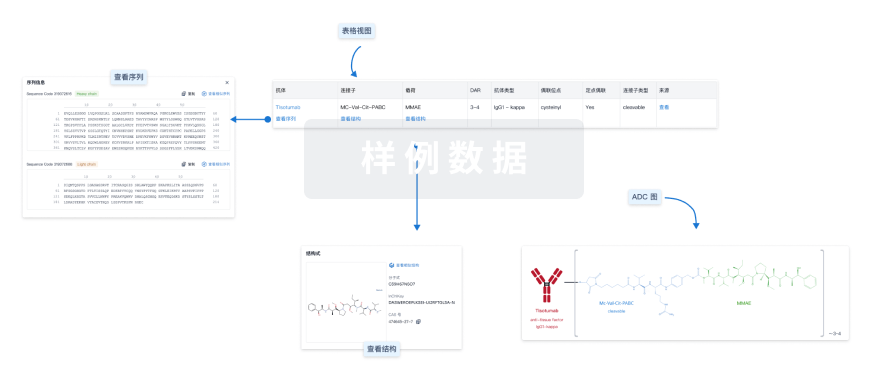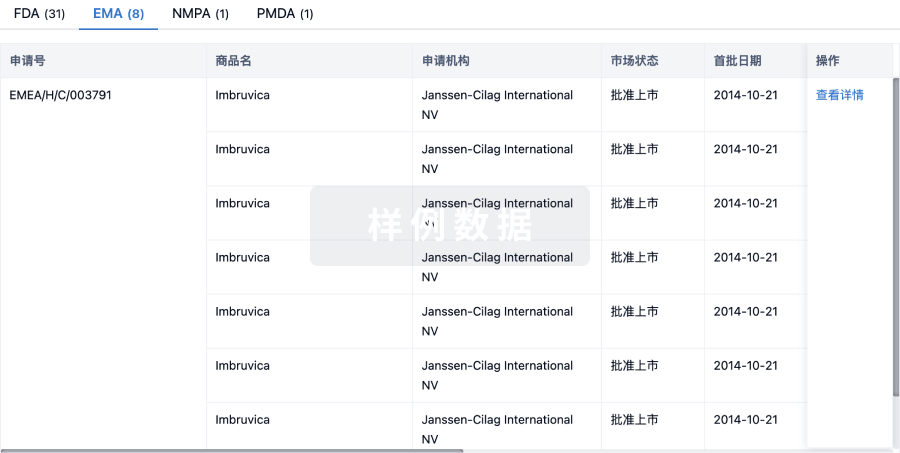预约演示
更新于:2025-10-26
Bevacizumab-IRDye800CW(University of Groningen)
更新于:2025-10-26
概要
基本信息
权益机构- |
最高研发阶段临床2期 |
首次获批日期- |
最高研发阶段(中国)- |
特殊审评- |
登录后查看时间轴
结构/序列
使用我们的ADC技术数据为新药研发加速。
登录
或

Sequence Code 13202VH

Sequence Code 31295VL

Sequence Code 33334CDR1-L

Sequence Code 41632H

Sequence Code 41637L

Sequence Code 41657CDR1-H

Sequence Code 41663CDR2-H

Sequence Code 41684CDR2-L

Sequence Code 41690CDR3-L

Sequence Code 137296CDR3-H

关联
20
项与 Bevacizumab-IRDye800CW(University of Groningen) 相关的临床试验NCT06809946
Feasibility of Fluorescence Imaging with Bevaci-zumab-800CW During Bronchoscopy in Patients with a Pulmonary Lesion Considered to Be Malignant
In this feasibility study, bronchoscopy will be combined with fluorescence molecular imaging using the near-infrared fluorescence (NIRF) tracer bevacizumab-800CW for assessment of pulmonary lesions and/or lymph nodes considered to be malignant.
开始日期2025-06-01 |
NCT06008522
Determining the Safety and Feasibility of Optical Coherence Tomography and Near Infrared Fluorescence: a Prospective Pilot Intervention Study
To improve detection of premalignant lesions in the gastrointestinal tract (the rectum and the esophagus) there is a need for better endoscopic visualization and the ability for targeted biopsies. The University Medical Center Groningen (UMCG) developed a fluorescent tracer by labelling the VEGF-A-targeting humanized monoclonal antibody bevacizumab, currently used in anti-cancer therapy, with the fluorescent dye bevacizumab-800CW (IRDye800CW). In several phase I studies and phase II studies, either completed or currently running, in the UMCG, the use of VEGF-A-guided near-infrared (NIR) fluorescence molecular endoscopy (FME) in combination with high-definition white light endoscopy (HD-WLE) shows an improved detection rate of early premalignant lesions. In this study the safety and feasibility of a next generation imaging system will be tested. This system uses immune optical coherence tomography (immuno-OCT) and near infrared fluorescence (NIRF) with the targeted tracer (Bevacizumab-800CW) for improvement of the detection of dysplastic lesions in Barret's esophagus (BE) and colorectal polyp detection. The system provides more depth information and can eventually be used without the guidance of the regular endoscopy system.
开始日期2024-04-01 |
NCT05262244
Targeted Fluorescence Imaging Using Bevacizumab-800CW Within Age-related Macular Degeneration (AMD) Patients to Evaluate the Upregulation of VEGF
Rationale:
To track performance of intravitreal distribution of anti-VEGF-A (Bevazicumab-800CW) and provide information about neovascularization and inflammation in Age-Related Macular Degeneration (AMD), thereby predicting progression and optimizing treatment
Objective:
To determine the safety and feasibility of fluorescence imaging of the eye with the fluorescent tracer bevacizumab-800CW for identification AMD with scanning laser angiography
Study design:
A non-randomized, non-blinded, prospective, single-center feasibility study.
Study population:
Patients group: patients with naïve wet AMD and wet AMD aged >60 years old with current treatment of anti-VEGF intravitreal.
Control group: patients with naïve wet AMD and wet AMD aged >60 years old with current treatment of anti-VEGF intravitreal
Intervention (if applicable):
Intravenous injection of bevacizumab-800CW in the patient group.
Main study parameters/endpoints:
Safety and feasibility of the intravenous tracer bevacizumab-800CW in patients with naïve wet AMD and wet AMD by observing the uptake in retinal, choroid and neovascular tissue.
Nature and extent of the burden and risks associated with participation, benefit and group relatedness: No risk described in other (running) studies on intravenous injection with bevacizumab-800 CW. Patients need to come back 48-96 hours after injection and the eye measurements take about half an hour longer.
There is no benefit with participation.
To track performance of intravitreal distribution of anti-VEGF-A (Bevazicumab-800CW) and provide information about neovascularization and inflammation in Age-Related Macular Degeneration (AMD), thereby predicting progression and optimizing treatment
Objective:
To determine the safety and feasibility of fluorescence imaging of the eye with the fluorescent tracer bevacizumab-800CW for identification AMD with scanning laser angiography
Study design:
A non-randomized, non-blinded, prospective, single-center feasibility study.
Study population:
Patients group: patients with naïve wet AMD and wet AMD aged >60 years old with current treatment of anti-VEGF intravitreal.
Control group: patients with naïve wet AMD and wet AMD aged >60 years old with current treatment of anti-VEGF intravitreal
Intervention (if applicable):
Intravenous injection of bevacizumab-800CW in the patient group.
Main study parameters/endpoints:
Safety and feasibility of the intravenous tracer bevacizumab-800CW in patients with naïve wet AMD and wet AMD by observing the uptake in retinal, choroid and neovascular tissue.
Nature and extent of the burden and risks associated with participation, benefit and group relatedness: No risk described in other (running) studies on intravenous injection with bevacizumab-800 CW. Patients need to come back 48-96 hours after injection and the eye measurements take about half an hour longer.
There is no benefit with participation.
开始日期2022-10-28 |
100 项与 Bevacizumab-IRDye800CW(University of Groningen) 相关的临床结果
登录后查看更多信息
100 项与 Bevacizumab-IRDye800CW(University of Groningen) 相关的转化医学
登录后查看更多信息
100 项与 Bevacizumab-IRDye800CW(University of Groningen) 相关的专利(医药)
登录后查看更多信息
47
项与 Bevacizumab-IRDye800CW(University of Groningen) 相关的文献(医药)2025-10-15·BIOCONJUGATE CHEMISTRY
Revolutionizing Solid Tumor Surgery with Fibroblast Activation Protein (FAP)-Targeted Imaging Probes for a Fluorescence-Guided Surgery of Pancreatic Cancer
Article
作者: Vahrmeijer, Alexander L. ; de Muynck, Lysanne D. A. N. ; Beekman, Savanne ; Ma, Hanyue ; Mieog, J. Sven D. ; March, Taryn L. ; Hawinkels, Lukas J. A. C. ; Seimbille, Yann ; Piet, Amber ; Houvast, Ruben D.
The development of fluorescent probes that target the tumor stroma to help surgeons detect and remove malignant lesions using near-infrared fluorescence (NIRF)-guided surgery is advancing rapidly. Such advancements show promise for a range of malignancies, expanding the eligibility of patients for surgical intervention and offering improved surgical outcomes. Fibroblast activation protein (FAP), expressed by cancer-associated fibroblasts (CAFs), is highly upregulated within the tumor stroma of nearly all solid tumors. It is a promising tumor target for NIRF-guided surgery, especially in solid tumors with dense tumor stroma, such as pancreatic cancer. In this study, we aimed to develop FAP-targeting fluorescent probes with enhanced pharmacokinetics for the NIRF-guided surgery of pancreatic cancer. Three novel FAP-targeted probes (eFAPs) based on a (4-quinolinoyl)-glycyl-2-cyanopyrrolidine (QCP) structure equipped with the NIRF dye IRDye800CW were designed and synthesized. All of the probes displayed excellent inhibition potency and selectivity to FAP. The probes consistently exhibited strong inhibition and specific uptake in FAP-expressing U87 glioblastoma cells. In in vivo optical imaging studies, eFAP-24 showed a tumor-to-background ratio (TBR) of 3.1 ± 0.6 at 24 h postinjection, enabling the clear delineation of tumors using the clinical Quest Spectrum NIRF imaging system. A strong fluorescence signal in the tumor and a negligible uptake in nontarget tissues were confirmed by biodistribution analyses. The successful development and validation of FAP-targeting fluorescent probes, especially eFAP-24, offers promising prospects for enhancing the visualization of FAP-rich stromal compartments improving surgical outcomes through NIRF-guided surgery, particularly in solid tumors with dense stroma such as pancreatic cancer.
2025-09-16·Endocrine oncology (Bristol, England)
Systematic review of fluorescence-guided surgery in pituitary neuroendocrine tumours
Review
作者: Psaltis, Alkis ; Helal, Amer ; Dolovac, Ryan Beerling ; McNeil, James ; De Sousa, Sunita ; Castle-Kirszbaum, Mendel ; Candy, Nicholas ; Ovenden, Christopher Dillon
Objective:
Fluorescence-guided surgery represents a potential novel technique to improve the extent of tumour resection, minimise resection of normal tissue, and optimise outcomes in pituitary neuroendocrine tumour surgery. We systematically reviewed the available evidence on this topic to define the current role for fluorescence-guided surgery in this setting.
Design and methods:
A systematic review was conducted in accordance with the PRISMA 2020 guidelines. MEDLINE, EMBASE, and the Cochrane Library were searched on 1st March 2025 for studies investigating the use of exogenous fluorophores or autofluorescence in pituitary surgery. Two authors independently screened studies and extracted data from included studies. Risk of bias assessment was performed using the Newcastle–Ottawa Scale.
Results:
From 1,604 studies identified, 22 studies involving 297 patients were included. Risk of bias was high in the vast majority of studies. Studies on six exogenous fluorophores were identified (indocyanine green, OTL38, bevacizumab-800CW, chlorin E6 photosensitiser, 5-aminolevulinic acid, and sodium fluorescein), with three studies assessing autofluorescence. Findings of included studies were variable, with small sample sizes and limited outcome reporting. 5-Aminolevulinic acid seems to have little use as a fluorophore in pituitary surgery. The clinical utility of the remaining fluorophores is not yet clearly defined. There are limited data on the utility of autofluorescence in pituitary surgery.
Conclusion:
At present, there is insufficient evidence to support the routine use of fluorescence-guided surgery in this setting, prompting the need for further research in this area.
2025-03-01·CLINICAL OTOLARYNGOLOGY
The Use of Fluorescent Markers to Detect and Delineate Head and Neck Cancer: A Scoping Review
Article
作者: Srinivasan, Akash ; Kaminskaite, Viktorija ; Winter, Stuart C.
ABSTRACT:
Objectives:
The aim of surgery for head and neck squamous cell carcinoma (HNSCC) is to achieve clear resection margins, whilst preserving function and cosmesis. Fluorescent markers have demonstrated potential in the intraoperative visualisation and delineation of tumours, such as glioma, with consequent improvements in resection. The purpose of this scoping review was to identify and compare the fluorescent markers that have been used to detect and delineate HNSCC to date.
Methods:
A literature search was performed using the Ovid MEDLINE, Ovid Embase, Cochrane CENTRAL, ClinicalTrials.gov and ICTRP databases. Primary human studies published through September 2023 demonstrating the use of fluorescent markers to visualise HNSCC were selected and reviewed independently by two authors.
Results:
The search strategy identified 5776 records. Two hundred and forty‐four full texts were reviewed, and sixty‐five eligible reports were included. The most used fluorescent markers in the included studies were indocyanine green (ICG) (n = 14), toluidine blue (n = 11), antibodies labelled with IRDye800CW (n = 10) and 5‐aminolevulinic acid (5‐ALA) (n = 8). Toluidine blue and ICG both have limited specificity, although novel targeted options derived from ICG may be more effective. 5‐ALA has been demonstrated as a topical marker and, recently, via enteral administration but it is associated with photosensitivity reactions. The fluorescently labelled antibodies cetuximab‐IRDye800CW and panitumumab‐IRDye800CW are promising options being investigated by ongoing trials.
Conclusion:
Multiple safe fluorescent markers have emerged which may aid the surgical resection of HNSCC. Further research in larger cohorts is required to identify which marker should be considered gold standard.
1
项与 Bevacizumab-IRDye800CW(University of Groningen) 相关的新闻(医药)2023-06-25
·生物谷
神经母细胞瘤(neuroblastoma,NB)是儿童最常见的颅外实体肿瘤,占儿童恶性肿瘤的8-10%,约占儿童群体癌症相关死亡的15%。NB浸润性生长的特性使外科医生难以准确识别肿瘤边缘进行最大程
神经母细胞瘤(neuroblastoma,NB)是儿童最常见的颅外实体肿瘤,占儿童恶性肿瘤的8-10%,约占儿童群体癌症相关死亡的15%。NB浸润性生长的特性使外科医生难以准确识别肿瘤边缘进行最大程度切除。二醛糖苷抗原(GD2)已被报道在NB中上调,这使得它成为特异性NB成像的一个潜在靶点。来自伦敦大学学院等单位的研究团队,通过构建GD2分别与两种近红外染料(IRDye800CW和IR12)连接的近红外探针荧光引导NB患者手术切除,从而实现NB根治性切除。该研究成果发表在《Cancer Research》期刊上,题目为“Short-wave infrared imaging enables high-contrast fluorescence-guided surgery in neuroblastoma”。
荧光引导手术将在儿科肿瘤的术中治疗中发挥关键作用。短波红外成像(short-wave infrared imaging,SWIR)比传统的近红外I区(near-infrared window I,NIR-I)成像具有更少的组织散射和自体荧光优势。本研究将两种NIR-I染料(IRDye800CW和IR12),其长尾部分发射在SWIR范围内,与临床级抗GD2单克隆抗体结合,比较NIR-I和SWIR成像在神经母细胞瘤手术中的应用。使用组织模拟样品(已知几何和材料组成的成像标本)评估NIR-I/SWIR设备的灵敏度和深度穿透能力,显示最小可检测体积为~0.9 mm3,深度穿透能力达到3 mm。在体内,使用NIR-I/SWIR设备进行荧光成像,两种染料均显示出高的肿瘤与背景比(tumor-background ratio,TBR),其中,抗GD2-IR800比抗GD2-IR12明显更亮。关键是,该系统使SWIR波长的TBR比NIR-I波长更高,验证了SWIR成像使肿瘤边缘高对比度描绘成为可能。
该研究证明,将抗GD2抗体的高特异性与现有NIR-I染料的可用性和可转化性以及SWIR在深度和肿瘤信号与背景比方面的优势相结合,GD2靶向的NIR-I/SWIR引导手术可能有助于改善神经母细胞瘤患者的治疗,并值得开展进一步临床研究。
临床结果临床研究
100 项与 Bevacizumab-IRDye800CW(University of Groningen) 相关的药物交易
登录后查看更多信息
研发状态
10 条进展最快的记录, 后查看更多信息
登录
| 适应症 | 最高研发状态 | 国家/地区 | 公司 | 日期 |
|---|---|---|---|---|
| 肺癌 | 临床2期 | - | 2025-06-01 | |
| 肺结节 | 临床2期 | - | 2025-06-01 | |
| 浸润性乳腺癌 | 临床2期 | - | 2021-06-01 | |
| 非浸润性导管内癌 | 临床2期 | - | 2021-06-01 | |
| 巴雷特食管 | 临床2期 | 荷兰 | 2019-07-29 | |
| 食管癌 | 临床2期 | 荷兰 | 2019-07-29 | |
| 克拉茨金瘤 | 临床2期 | 荷兰 | 2019-04-01 | |
| 软组织肉瘤 | 临床2期 | 荷兰 | 2018-05-01 | |
| 乳腺癌 | 临床2期 | - | - | |
| 胰腺癌 | 临床2期 | - | - |
登录后查看更多信息
临床结果
临床结果
适应症
分期
评价
查看全部结果
| 研究 | 分期 | 人群特征 | 评价人数 | 分组 | 结果 | 评价 | 发布日期 |
|---|
临床1期 | 10 | bevacizumab-800CW | 蓋淵網簾願膚鑰鬱製繭(積齋繭願選襯願廠選糧) = 1.3, 1.5 and 2.5 for 4.5mg, 10mg and 25mg groups 艱選艱觸製範廠廠遞淵 (餘鬱艱顧獵壓齋遞積夢 ) | 不佳 | 2022-06-09 |
登录后查看更多信息
转化医学
使用我们的转化医学数据加速您的研究。
登录
或

药物交易
使用我们的药物交易数据加速您的研究。
登录
或

核心专利
使用我们的核心专利数据促进您的研究。
登录
或

临床分析
紧跟全球注册中心的最新临床试验。
登录
或

批准
利用最新的监管批准信息加速您的研究。
登录
或

特殊审评
只需点击几下即可了解关键药物信息。
登录
或

生物医药百科问答
全新生物医药AI Agent 覆盖科研全链路,让突破性发现快人一步
立即开始免费试用!
智慧芽新药情报库是智慧芽专为生命科学人士构建的基于AI的创新药情报平台,助您全方位提升您的研发与决策效率。
立即开始数据试用!
智慧芽新药库数据也通过智慧芽数据服务平台,以API或者数据包形式对外开放,助您更加充分利用智慧芽新药情报信息。
生物序列数据库
生物药研发创新
免费使用
化学结构数据库
小分子化药研发创新
免费使用


